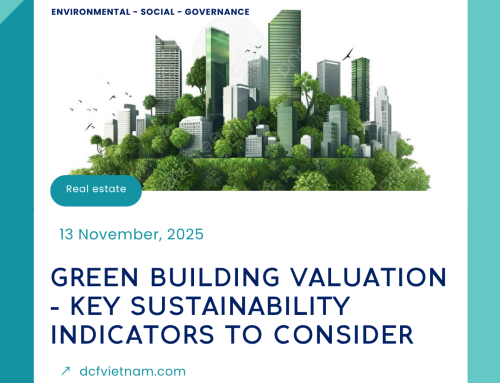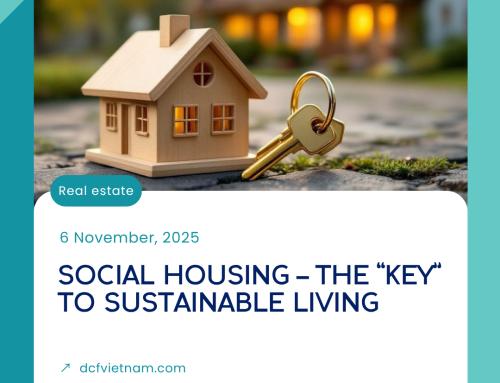CURRENT REALITY & OPPORTUNITY
Burden of Operating Costs
It is estimated that energy currently accounts for 30–40% (or about 1/3) of the total operating costs of a commercial building.
Amidst the context where the average electricity price in Vietnam has increased by more than 10% in just the last 5 years and the proposed amendment to Decree 72 could increase electricity prices by 2-5% annually, every square meter of floor space is becoming an ever-increasing cost burden.
Increased Asset Value
20–30%
Implementing energy efficiency solutions can help reduce operating costs, immediately translating to improved net profit and asset value.
The question for owners is: continue accepting annual profit "bleeding" into utility bills, or invest in transformation to turn energy costs into a competitive advantage and increase rental value?

1. Context
1.1. International
Following the 2022–2023 energy crisis, the challenges of operating costs and climate change have become a dual pressure on commercial real estate. According to UNEP (2023), buildings currently account for about 40% of global CO₂ emissions. This explains why Net Zero 2050, ESG, and cross-border carbon tax policies are compelling international investors to shift capital into green buildings. In this landscape, energy efficiency emerges as the most direct and measurable solution to both reduce emissions and strengthen asset value. In other words, the ability to save energy not only helps cut costs but also becomes the "common language" for real estate to access global capital flows.
1.2. Domestic
In Vietnam, environmental and energy challenges are most evident in major cities. Hanoi and Ho Chi Minh City frequently rank among the top 40 most polluted cities worldwide (IQAir, 2024), while the construction sector accounts for over 35% of the country's total electricity consumption (Ministry of Construction, 2024). Specifically, extreme heat conditions cause commercial buildings to rely heavily on air conditioning, which consumes 60–75% of a building's total electricity. Unlike regular appliances, air conditioners also emit CO₂ and CFCs—leading contributors to climate change and ozone depletion. Thus, energy is both a cost burden and a hazardous emission source that needs control.
To respond, the State has issued several policies: the Law on Economical and Efficient Use of Energy (2010), the Green Growth Strategy 2021–2030, and QCVN 09:2017/BXD on energy-efficient buildings. In this context, improving energy efficiency not only helps reduce operating costs but is also a core strategy to curb emissions, meet ESG requirements, and maintain the competitive appeal of commercial real estate.
2. What is Energy Efficiency? - Concepts and Common Standards
Energy efficiency in commercial real estate is the ability to maintain the building's operational quality (lighting, air conditioning, elevators, technical systems) with minimal energy consumption. This not only reduces operating costs but also limits greenhouse gas emissions, thereby increasing both tangible value and ESG credibility for the building. To measure energy efficiency, one of the most widely used international tools is the LEED (Leadership in Energy and Environmental Design) certification, developed by the U.S. Green Building Council (USGBC). LEED establishes a comprehensive scoring system, where the Energy & Atmosphere category accounts for a significant portion (about 30–35% of the total score). LEED-certified projects must typically demonstrate energy savings of 25%–30% or more compared to conventional designs, depending on the certification level (Certified, Silver, Gold, Platinum).
LEED is chosen for analysis over other certifications (EDGE, BREEAM, LOTUS) for three main reasons: Comprehensiveness, International Reputation, and Financial Impact:
Comprehensiveness – It quantifies not only energy efficiency but also evaluates air quality, location, materials, water, and operations.
International credibility – LEED is widely recognized worldwide, and many multinational corporations and international tenants consider it the “default standard” when selecting office space.
Financial Impact – LEED-certified projects have an advantage in attracting green finance, as well as increasing rental value and occupancy rates.
3. Mechanism of Impact on Rental Price
3.1. Energy Efficiency Reduces Operating Costs for Investors
Energy is the largest operating expense in a commercial building, especially cooling costs which are high in a tropical country like Vietnam. With the continuous trend of rising electricity prices, this cost is increasingly becoming a burden for both investors and tenants.
In commercial real estate operations, tenants are not only concerned with the nominal rent (USD/sqm/month) but often evaluate based on the total occupancy cost, which includes both rent and service fees (electricity, water, maintenance, etc.). This is the key point explaining why energy efficiency can directly impact rental prices.
According to IFC estimates, buildings that adopt energy-saving solutions can reduce electricity costs by 20–30% compared to conventional buildings. This figure, when translated into reality, equates to billions of VND annually for a large-scale Grade A building. Consequently, energy-efficient buildings often have the ability to maintain or even increase rental prices by about 7-10% and still be accepted by the market. This is because, based on the final total cost, tenants are not "losing out": they pay more in nominal rent, but save a large amount on utility bills.
Case study: For the same rent of 60 USD/sqm, if a conventional building spends 6 USD/sqm on operating costs, the remaining net profit is only 54 USD/sqm. Meanwhile, an energy-efficient building only loses 4.8 USD/sqm in operating costs, increasing the net profit to 55.2 USD/sqm. Thus, even with the same rent, the investor's actual profit is higher, and the tenant also benefits from a lower total cost.
Conversely, less energy-efficient buildings are forced to compete by lowering rental prices to offset the operating cost burden for tenants, leading to a decline in long-term profit margins.
3.2. Attracting International and High-Quality Tenants
One of the major drivers making energy efficiency a decisive factor in commercial real estate is the changing demand from international tenants and multinational corporations. Unlike domestic SMEs that primarily focus on cost, large corporations view energy efficiency and green certification as mandatory standards when selecting offices.
The reason stems from the pressure to implement ESG (Environmental – Social – Governance) and global Net Zero commitments. Currently, most multinational corporations have integrated emissions reduction targets into their operational strategies, where choosing an office in a green building is considered the most direct and easiest measure to implement. Therefore, these tenants are willing to pay a premium of 5–15% higher rent for offices meeting energy efficiency standards, provided it helps them comply with ESG reporting to their parent company and investors.
Internationally, this trend is even clearer: in Singapore, nearly 80% of newly delivered Grade A office space is green certified, and multinational tenants almost do not consider uncertified buildings. In reality, in Bangkok—one of Southeast Asia's most dynamic office markets—according to The Nation, green-certified commercial buildings command a rental premium of 4–11% higher than conventional buildings.
The key point here is: international tenants are not only a group willing to pay a high price, but also stable and long-term. When large corporations sign 5–10 year leases to secure their ESG strategy, investors benefit from stable cash flow and more sustainable asset value. A study by Kok & Jennen (2012) in the Netherlands showed that offices with high energy performance certificates (Energy Performance Certificate – EPC from Grade A to C) achieved an average rent 6–7% higher than low-grade offices (EPC D and below). This proves that, in practice, the market already prices a "green premium" for buildings capable of energy saving.
Thus, energy efficiency is not merely a competitive advantage; it has become the "entry ticket" to access the international tenant segment—premium customers who pay well and help elevate the building's reputation in the market.
3.3. Enhancing Building Image and Brand
Achieving energy efficiency certification today is not just proof of cost savings, but also an extremely effective “passive marketing strategy.” Green buildings are often preferentially mentioned in market reports by major organizations, which always dedicate a section to the “green office” trend. Appearing in these reputable reports means free promotion to investors, international tenants, and media, thereby enhancing the brand image without direct advertising costs.
Energy efficiency certification also helps the building mitigate risks from increasingly stringent energy policies. Examples include the Law on Economical and Efficient Use of Energy; the Green Growth Strategy 2021–2030, which outlines an emission reduction roadmap, and QCVN 09:2017/BXD, which mandates standards for the envelope, air conditioning, and lighting systems for new constructions. Furthermore, the average annual electricity price adjustment trend of 2–5% and the carbon tax trend (expected from 2027 based on Net Zero commitments) will subject less energy-efficient buildings to increasingly high operating and compliance costs. Conversely, certified green buildings are nearly "immune" to this risk, thereby creating a safer perception in the eyes of foreign investors—who prioritize long-term stability.
In other words, energy efficiency is both a tool for a commercial property to stand out in the domestic market through recognition in reputable reports, and a guarantee of stability and safety against policy changes—factors that help win over international tenants and investors.
4. Case Studies
4.1. In Vietnam: Deutsches Haus (Ho Chi Minh City)
Deutsches Haus is the first project in Vietnam to achieve LEED Platinum certification—the highest standard for green buildings. According to the investor's report, the building can save approximately 40% energy compared to conventional projects by implementing double-glazed thermal glass systems, high-efficiency central air conditioning, and smart energy management solutions. Thanks to this operational efficiency, the building maintains one of the highest rental prices in the Ho Chi Minh City office market, while sustaining an occupancy rate above 95%. This demonstrates that low operating costs not only increase net profit for the owner but also allow them to confidently maintain high rental prices, targeting international tenants with strict ESG requirements.
This domestic example shows that implementing energy efficiency solutions is no longer a “plus factor” but has become a prerequisite for a Grade A building to maintain its position and attract international tenants.
4.2. International: Study in the Netherlands
If LEED-certified projects in Vietnam have shown a clear competitive advantage, quantitative studies on the international stage confirm a similar trend. A notable study by Kok & Jennen (2012) involving over 1,100 office leases in the Netherlands between 2005–2010. Results showed that buildings with high energy performance labels (Energy Performance Certificate – EPC from Grade A to C) achieved an average rent 6.5% higher than those with lower grades (EPC D and below), after controlling for factors such as location or amenities. This proves that energy efficiency is not just symbolic but genuinely translates into tangible financial value in the rental market.
Case studies in Vietnam and the Netherlands both indicate that green building certification and energy efficiency solutions not only reduce operating costs but also directly enhance asset value by increasing rental prices and the ability to attract high-quality customers.
5. Conclusion
Energy efficiency is no longer just a technical choice but has become a strategic factor that increases both the tangible and intangible value of commercial real estate in Vietnam. Regarding tangible value, cutting 20–30% of energy costs during operation directly reduces operating expenses, thereby creating room for owners to raise rent or improve profit margins while maintaining tenant appeal. This is especially crucial as electricity costs continue to climb, accounting for 30–40% of total operating expenses, making every saved kWh a clear competitive advantage.
Concurrently, intangible value is strongly reinforced. Buildings with high energy efficiency not only attract international tenants who prioritize ESG factors but also elevate the developer's brand as a "responsible developer." This image makes it easier for the building to access green financing or preferential credit from global financial institutions, thus increasing asset value beyond immediate profit.
From this perspective, energy efficiency during the operational phase is clearly the foundation for building a competitive edge for existing commercial real estate. However, the open question for future research is: can commercial real estate developed in the future go further by integrating carbon emission reduction from the design and construction phases? This will be the focus of the next topic: “Carbon Emission Reduction – A Factor Attracting International Tenants in Commercial Real Estate,” where the focus shifts from just the operational phase to the entire lifecycle of the building.
AUTHOR &
CONTACT INFORMATION
REFERENCES
DISCLAIMER
This content is the product of the author and does not reflect the views or stance of DCF Vietnam Corporation. Furthermore, this content is not intended to create a valuer-client relationship, does not constitute valuation/consultation, and does not replace professional valuation/consultation services. Actual and specific situations or assets require consultation with a professional valuer before taking any action related to the subject matter discussed herein.





